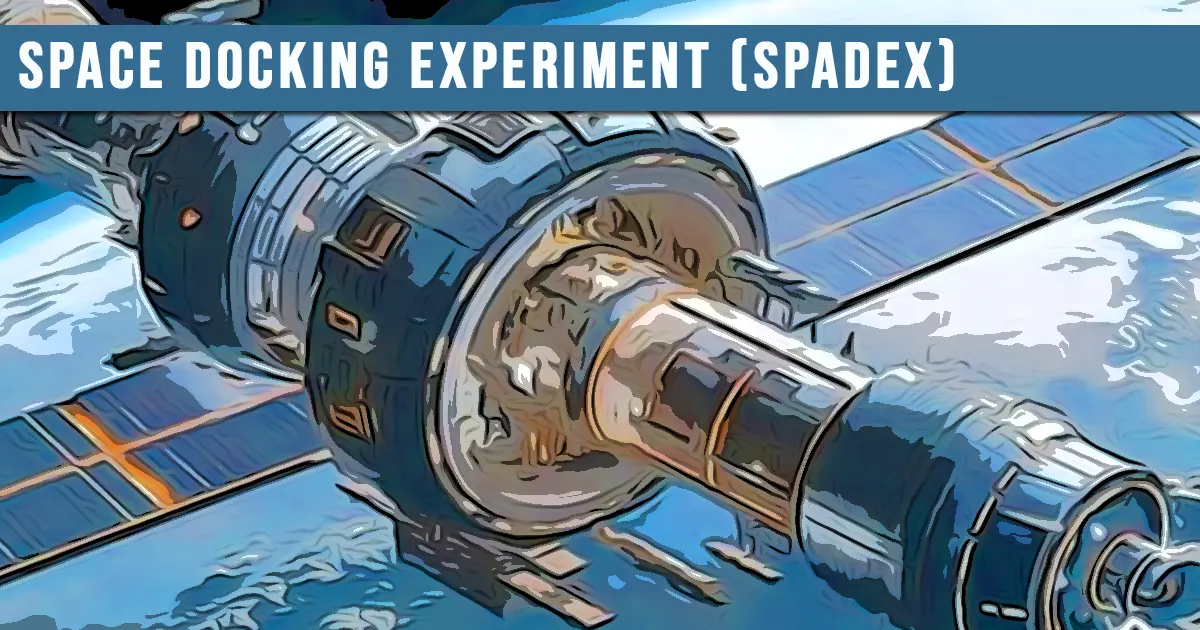GS 3-Space

Why in News?
Recently, a Hyderabad-based private company handed over two 400 kg class satellites to ISRO. These satellites will participate in the Space Docking Experiment (SPADEX) scheduled for late 2024.
About Space Docking
Space docking refers to the precise connection of two spacecraft, whether manned or unmanned, enabling them to function as a single unit for activities such as refueling, repairs, and crew exchanges. It is a critical technology for building advanced space facilities like the International Space Station (ISS) and furthering space exploration.
- Docking vs. Berthing:
- In docking, the spacecraft autonomously maneuvers and attaches itself to the station.
- In berthing, astronauts use the station’s robotic arm to capture the spacecraft, and ground-based Mission Control guides the arm to secure the spacecraft at the docking site.
About SPADEX
SPADEX is a technology demonstration mission by ISRO aimed at achieving autonomous space docking, a capability mastered only by a few countries like the US, Russia, and China.
- Key Features:
- Satellites: The two satellites, Chaser and Target, will be launched into slightly different orbits by a single PSLV-class vehicle to dock at an altitude of about 700 km.
- Docking Maneuver: The satellites will align at speeds of ~28,000 km/h to dock and form a single orbiting unit, referred to as a “space handshake.”
- Operations and Experiments:
- Autonomous Rendezvous and Docking: The satellites will autonomously navigate, approach, and dock.
- Formation Flying: Demonstrating precision orbital control to maintain relative positions.
- Remote Operations: Testing the ability to control one satellite using the Attitude Control System of the other.
- Robotic Arm Testing: Exploring in-space servicing and manipulation capabilities.
Significance for India
- Advancing Space Exploration: SPADEX demonstrates indigenous scalable and cost-effective docking technology crucial for:
- Gaganyaan (human spaceflight).
- Chandrayaan-4 (lunar sample returns).
- Bharatiya Antariksha Station (permanent space infrastructure).
- Boosting Private Sector Participation: This marks a significant milestone in private sector involvement, with a private company fully integrating satellites for ISRO use, facilitated by space sector reforms like IN-SPACe.
- International Collaboration and Future Impact: SPADEX lays the groundwork for building global partnerships in space infrastructure development and deep space exploration, while also opening avenues for earning foreign exchange.
- Other Applications: Enhancing the lifespan of geostationary satellites, assembling space-based solar stations, and future interplanetary missions (e.g., Mars exploration).
Challenges
- Complex Docking Mechanisms: Achieving precise communication and coordination at extremely high speeds (~8-10 km/s) is challenging and leaves little margin for error.
- Autonomous Operations: Managing real-time maneuvers under dynamic conditions requires advanced technology.
- Sensor Reliability: Docking sensors like cameras, LIDAR, and radar must operate reliably in the harsh space environment.
- Other Risks: Potential threats from space debris, microgravity effects, and ensuring stable data transfer and communication.




